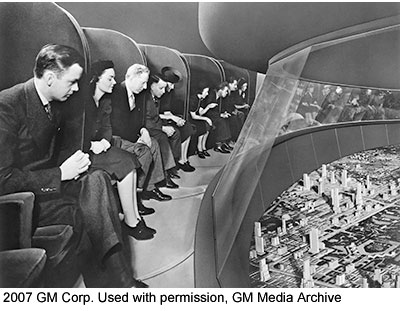On Driverless Car Technology
In a previous post, I referenced Randal O’Toole’s book, Gridlock: Why We’re Stuck in Traffic and What to Do About It, in which he details some policy recommendations for both the Federal and State governments with regard to transportation policy. One of the recommendations is to reduce the current restrictions so that driverless cars can become a reality much faster. This is simply brilliant.O’Toole notes that much of the technology needed exists today. In fact, many high-end vehicles already have the ability to vary cruise control speeds based on traffic conditions, assist the driver in staying in lanes, and even parallel park themselves. He sees two possible model for the future. The first, the Bel Geddes model, named after the designer of the Futurama exhibit at the 1939 World’s Fair (see picture), would involve technology located in both the roads and the vehicles. The second, the DARPA model, named after the Defense Advanced Research Projects Agency, would require no modifications to the roadways instead concentrating the technology in the vehicles themselves.(By the way, DARPA developed a little thing called DARPAnet which, when privatized, became known as the Internet. No Al Gore did not create it.)O’Toole’s research indicated that implementing driverless car technology would:
He sees two possible model for the future. The first, the Bel Geddes model, named after the designer of the Futurama exhibit at the 1939 World’s Fair (see picture), would involve technology located in both the roads and the vehicles. The second, the DARPA model, named after the Defense Advanced Research Projects Agency, would require no modifications to the roadways instead concentrating the technology in the vehicles themselves.(By the way, DARPA developed a little thing called DARPAnet which, when privatized, became known as the Internet. No Al Gore did not create it.)O’Toole’s research indicated that implementing driverless car technology would:
- Quadruple the capacity of current roads from 2,200 cars per lane per hour to 8,000.
- Eliminate congestion that results from slow driver reaction times, this would also save energy.
- Reduce driver error significantly – the cause of the majority of fatal highway accidents – this would increase highway safety greatly.
The book goes on to discuss four possible scenarios for implementation. The one I believe has the best chance for success, O’Toole calls the Computer Model. Based on how the PC market has developed and deployed standards for peripherals such as printers and hard drives, this model would create the standards that would be openly published with the expectation that car manufacturers will make products that use them.If elected, I would lead the charge for the State of Texas to lead the way. Specifically, the Texas Transportation Code, Title 7 – Vehicles and Traffic, Subtitle C – Rules of the Road, Section 545.001 and 545.002 will need to be adjusted. The issue with the regulations in all states is that they assume the operator is in control of the vehicle. With driverless car technology this would obviously not be the case.(The video below demonstrates a driverless car that plans to ascend Pikes Peak later this month.)
